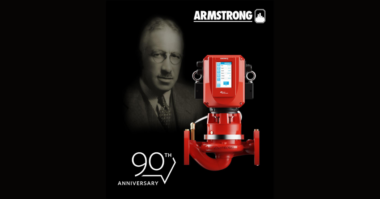Featuring Expanded Energy Savings Solutions
Armstrong Fluid Technology has announced the introduction of its Generation Three Design Envelope pumps featuring 33 advanced energy savings models ranging in sizes from one to 75HP. All of these pumps are available for two to 10 day express shipment.
Expanding on its innovative Design Envelope (DE) technology that has saved building owners worldwide millions of dollars, the new pumps are designed to further increase building owners’ energy savings while providing more sustainable solutions.
“The Design Envelope technology integrates the latest selection, control and hydronic tools into heat-transfer solutions that naturally accommodate changes in building design and demand to ensure that system performance is at an optimum at any given time,” according to Lex van der Weerd, CEO of Armstrong Fluid Technology. ”It is a more intelligent method of ensuring better HVAC equipment efficiency and achieving the lowest lifecycle cost.”
The new Generation 3 DE pumps also feature:
- TEFC Motors as standard to 25HP
- 230/460/575V options
- Fixed configuration codes for ease of product identification and order entry
- “Flat Map” selection
- Two to 10 day express shipment
- Exceeds ASHRAE 90.1 energy standard for buildings
Armstrong’s Design Envelope technology is built around four core competencies: heat transfer, fluid flow, variable speed, and demand based control. The technology delivers optimized lifetime building performance by modeling equipment and system behavior, monitoring authentic system conditions, and dynamically adjusting equipment operation to match system demand. This is achieved through specific Armstrong product combinations that make up a suite of solutions. Those products are pumping systems, booster systems, an Intelligent Fluid Management System (iFMS), an Integrated Plant Controller (IPC), a Chilled Water Integrated Plant Package (IPP), and Compass circulators.
For more information on Armstrong Fluid Technology products, visit www.armstrongfluidtechnology.com/DesignEnvelopeSymposium/ApplicationGuides
About Armstrong Fluid Technology
With over 1000 employees worldwide, operating seven manufacturing facilities on three continents, Armstrong Fluid Technology is known around the world as a forerunner and innovator in the design, engineering and manufacturing of intelligent fluid flow equipment. With its expertise in fluid dynamics, heat transfer, variable speed, and demand-based control, Armstrong Fluid Technology leads the fluid systems industry, including HVAC, plumbing, and fire safety in providing the most energy efficient and cost effective solutions to building professionals and owners around the globe.





Comments